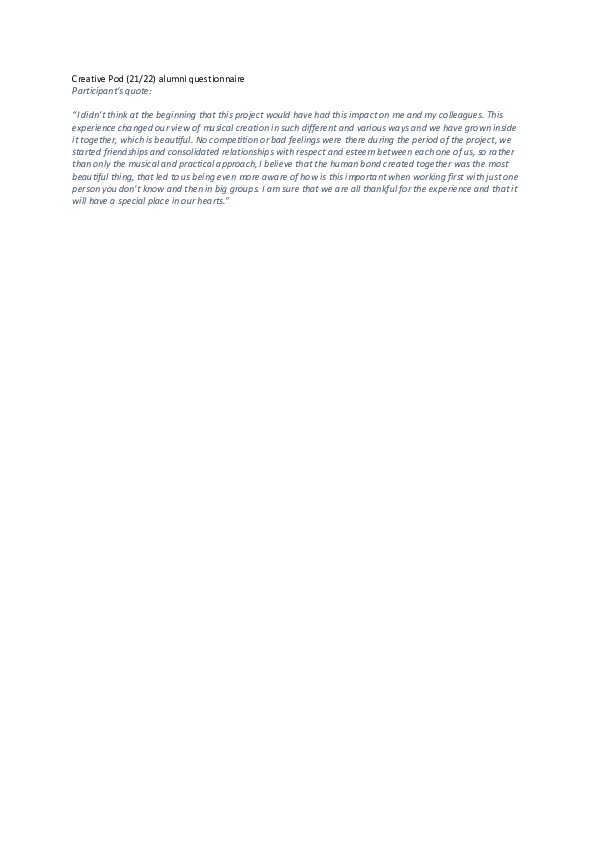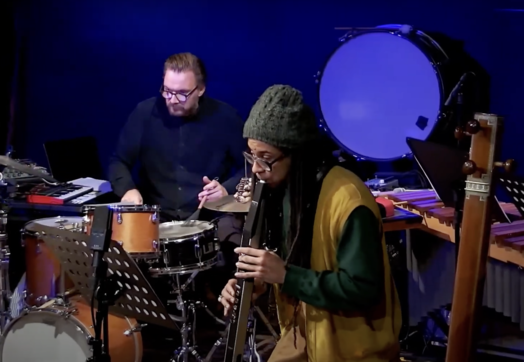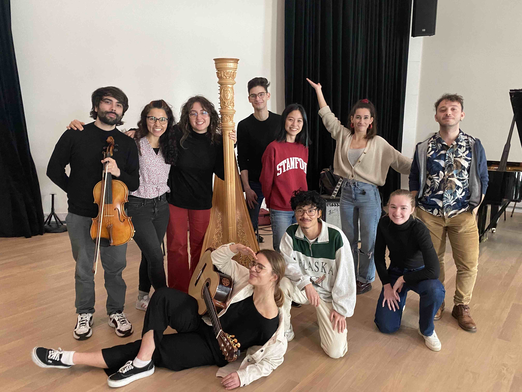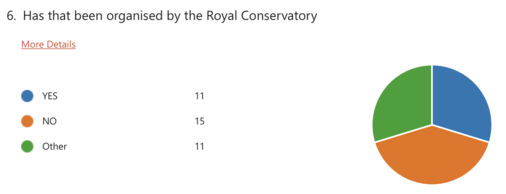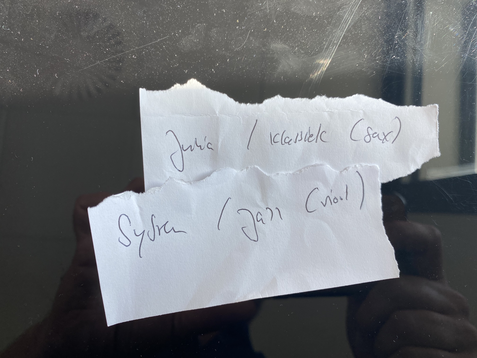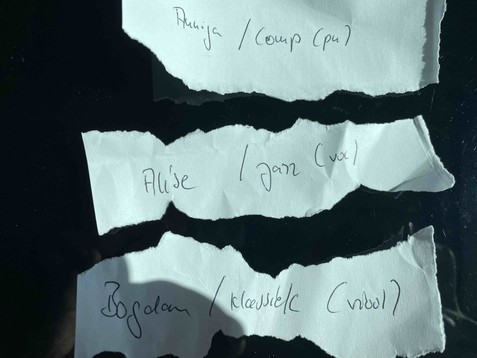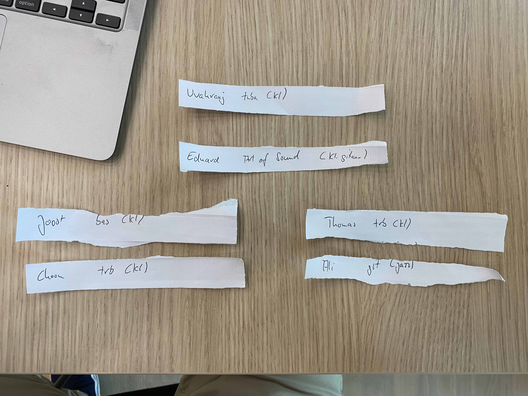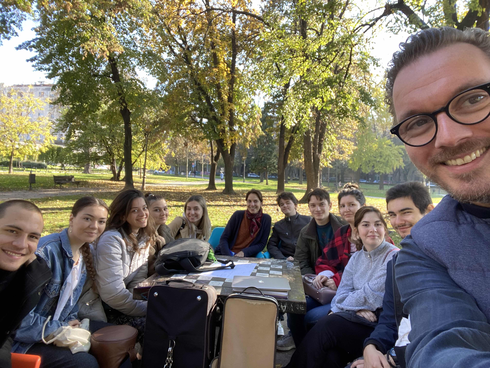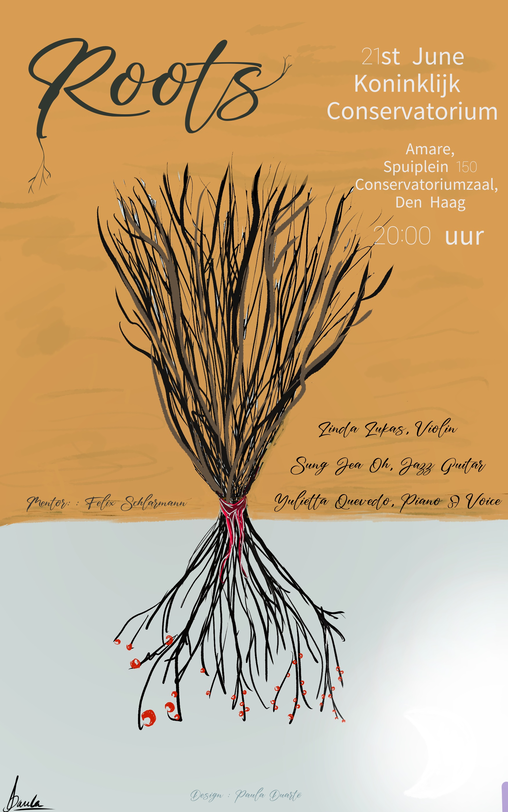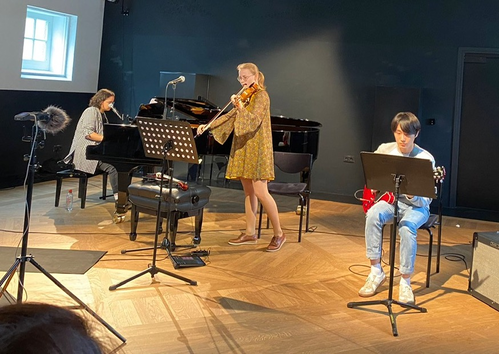"Always new and unexpected – this time it was the entirely open and collaborative approach of all of our group members – exceptional individuals in their own right – brilliant that we made something that was more than the sum of its parts in such a short space of time"
"LOVED IT – felt energized, free, engaged and fulfilled!"
Participants’ responses – ICONgo questionnaire
What was challenging, new, interesting, surprising, unexpected or intriguing during the process for you personally?
"It was challenging not to fall back into old habits"
"It was challenging to go out of one’s own habits and comfort zone in the feedback sessions/training (in small groups). It was unexpected that the groups made such lovely performances in such a short time. It was interesting to notice how comfortable I felt in what would normally be a very uncomfortable setting (improvising in front of others, singing in front of others, sharing personal stuff)"
"I was surprised at how quickly I and the others were able to share and connect at a deep level and how inspiring that was."
What did you learn from the experiences during these sessions, how did it effect you?
"I learned that there is really no need to be afraid of something beforehand. That I’m capable of more than I think myself. That others have issues too. That letting go of judgment is something I could do more often. That asking open, non-judgmental questions empower the person you are talking with and that receiving such questions are really helpful in one’s own thinking and problem-solving. That it’s wonderful to be able to use manifold sides of one’s artistic self."
"I learned how important it is to listen and make space; how showing vulnerability and being explorative can be strengthening. I experienced being able to accept myself rather than have all the answers – and be able to ask others for ideas and help, which felt strangely empowering."
“[…] I find this kind of interdisciplinary event very important for an institution like KonCon. It’s effective on so many fronts: connecting departments and their idioms, allowing people to put their own practice into perspective, letting go of all knowledge and just making music intuitively, making friendships, collaboration, the list goes on. Also, […], the constructive critique sessions were very good for learning to communicate your experience to others, rather than giving a biased opinion. That should be a mandatory skill to learn at the conservatoire.”
Participant’s quote taken from the questionnaire:
Why did you choose this elective and what do/did you hope/expect to get out of it?
“I chose it to find out more about myself and the freedom that music can offer. I love creating with people outside of my discipline, but it is still a psychological struggle for me to step out of my comfort zones. So, this is exactly what I expected – to create with people from different areas of artmaking.”
During the course of this research lectorate term several interdepartmental cross-genre projects have been conducted in order to investigate how different formats, length, group sizes and compilations of participants influence the students’ experience and motivation, next to the artistic and learning outcomes.
In addition to that, a series of questionnaires have been designed to gain specific data on this topic from students, participants of the case studies, professionals and teachers.
This chapter gives an overview of the activities, the processes, the used tools and the preliminary findings.
(The complete documentation of the conducted case studies and analysis of the designed questionnaires can be found in chapter #3)
CASE STUDIES #1 - Earlier work
KC Elective 'The Collective Approach' and survey (school year 2021/2022)
ABOUT
In my elective ‘The Collective Approach’, open for students of all departments, collaborative cross-genre work is approached over a term of two semesters. The course works towards creating and performing a concert program, curating and organizing it including finding a location and doing the promotion. The aim is combining artistic and entrepreneurial work while using the participants’ skills of both fields in the most effective way. The idea is inspired by the philosophy and work of the Amsterdam based Splendor Collective. (add link)
During this course a mix of collaborative musical exercises, entrepreneurial lectures, location visits, interviews with professionals from the field and moments for free creative space form the curriculum. (link curriculum handbook) In the end of the school year the participants have been asked to fill in a questionnaire.
PROCESS
In the school year 2021/2022 four students of three different departments (Classical music / vocal / jazz) joined the course. Scheduled sessions took place every two weeks, altering creative playing sessions and guided collaborative exercises with informational sessions and guest lectures. Extra sessions at external locations like Splendor Amsterdam have been added to the schedule. Two concluding presentations took place, one in Amare and one at Splendor Amsterdam.
Noticeable during the process were enthusiastic responses to first collaborative creative processes, followed by a growing irregular attendance, general problems with time management and a rising loss of motivation and focus towards the end of the school year, resulting in a rather stressful preparation of the, in the end surprisingly satisfying, final presentation.
TOOLS
In the course of the sessions I tried and developed a couple of strategies and exercises for musical collaboration, creation and curation:
- Pressure cooker sessions: create something (meaningful) in a short amount of time (as a group and in smaller sub-groups)
- Guided pressure cooker session with beforehand a clear overview of musical parameters and objectives that could help finding a direction or give helpful limitations while improvising (link to parameter sheet)
- Introduce a phrase from any work and have it played and developed collectively; let the students think of similar material and let them work with and improvise on it.
- Bring a tune, melody or phrase from your tradition or country, and one coming from your profession; take that as a starting point for a collective creation or as a curational basis for a concert program.
MAIN FINDINGS
- The first spontaneous creative moments are powerful, inspiring and motivating; the used tools function
- Long running electives form a challenge concerning motivation, focus and autonomy, time management and full schedules are main issues
- Final presentations should not interfere with exams but be planned in calm periods of the academic year
- The participants who chose to be part of the elective had the biggest artistic input and showed the most motivation and creativity compared to the student who was assigned.
- Instrumentation and personalities make every process unique, the importance lies in the balance of the collective process, the creation and curation, rather than in the outcomes.
The list above includes the main findings from the questionnaires, where participants mentioned mainly that not a lack of motivation but time management had formed the biggest issue for the unbalanced involvement.
PRELIMINARY CONCLUSION
Combining cross-genre music making, creative collaborative processes and entrepreneurial skills in one elective was a challenge, but yet interesting and satisfying for the participants. A challenge for the student since it asked attendance, focus, motivation and autonomy over a course of two semesters, and for the teacher since the gap between the two-weekly sessions take out the energy of the process, therefore ask for a well-balanced structure. But interesting since many aspects of the course have been new and inspiring to the participants.
Questionnaires participants of creative pod during research project 2021
ABOUT
In June 2022 a questionnaire was send out to the participants of last terms research project, the first project about a collaborative creative activity in both duo settings as well as group work (see chapter #1). All participants had been recruited.
MAIN FINDINGS
The reactions are still positive and inspiring. Some of the participants mention to be influenced by last year’s experiences in their choice of repertoire, their musical direction and their projects, next to being more open towards other genres, musicians and scenes. For some the experience opened new doors in their professional field, too.
None of the students continued the duo they performed with during the project, or started a similar duo or project yet. Only one participant mentioned musical reasons for that, the majority is simply too busy to do it.
PRELIMINARY CONCLUSION
Last year’s conclusions are still valid. The project had been artistical enrichening and opening up horizons for all responders. But the hope of the researchers was not confirmed: none of the participants found the time to go further with their duo or did initiate something new. Even though a lack of time was mentioned being the main reason, motivation might lack, too. Reasons could be a missing vision on future possibilities or clear benefits for their starting professionals.
CASE STUDIES #2 - Three activities during start-up week 2022
During the start-up week of the new academic year 2022-2023 I conducted three case studies: a survey addressing all first-year students, a ‘collaborative music creation’ course for one group of students throughout the week and three daily single workshops for changing groups of students. I was hoping to gain insights on first-year students’ reactions on cross-genre activities next to their experiences and expectations concerning this topic. In addition to that I planned to compare the different compilations of the groups, the length and settings, as well as group dynamics and their motivation comparing an assigned group to workshop participants who signed up.
Additionally, I have been involved in the Entrepreneurial Bootcamp for all second-year students, which included collaborative interdepartmental aspects, too.
Questionnaire for all participants of CMC sessions, KC start-up week 2022
ABOUT
During the start-up week of the new academic year 2022/2023 all first-year students had been assigned to a CMC session (Collaborative Music Creation). I was coaching one group myself but handed out questionnaires to all 1st year students, who followed this course in different groups with different coaches. Additionally, all coaches had been asked about their approach on the course.
By doing this I hoped to get a picture of how first-year students react on these activities, what their experiences and expectations are when it comes to cross-genre activities, and how these courses are approached by different coaches, and how these different approaches influenced the students’ experiences.
MAIN FINDINGS
87% of the responders would like to do something like the CMC again. While almost all participants listen to multiple musical genres, and around 75% mention experience with playing at least one other genre than the own, only half of the responders mentioned to have gotten in touch with any kind of improvisation and been involved in any kind of crossover (cross-genre) performances. Also, 58% mentioned to somehow having been comfortable with the content of the sessions, the rest was rather uncomfortable.
Concerning their answers, most participants had never done something like this before, and had been surprised by the new musical results one could achieve in a cross-genre setting, the artistic freedom and the none-judgmental environment. Also, working with peers from other departments in an open-minded atmosphere has been perceived as surprisingly pleasant and meaningful. Remarkable learning outcomes occurred, due to the participants gaining flexibility, letting go of only focusing on perfection and control, developing openness in a musical and social sense and getting new perspectives of making music.
Another interesting fact is, that the participants mention to have had very similar experiences despite the fact that they participated in different groups and therefore different approaches of the several coaches.
PRELIMINARY CONCLUSION
It is noticeable that the big majority of the 82 responders is positive about the CMC courses, the process, the outcome and their learning experiences. Eventually one needs to take into consideration that the students who did not enjoy the course, or did not see anything useful in it, had simply not responded to the survey. Nevertheless, due to the high number of responses, this result gives a clear picture of the 1st year bachelor students’ interests concerning cross-genre activities within the conservatoire, but also about their wide range of interests and experiences. Mainly, the experience of such activities itself seem to be most meaningful to the students, less the varying approaches of the coaches. It shows that a preference for specialization, certain approaches or directions might be interesting in a later state, but is less relevant at an entry level, where most participants enter a totally new artistic situation. (Find a full report of the questionnaire in the appendix.)
Facilitating one of the CMC sessions, KC start-up week 2022
ABOUT
During the same start-up week at the beginning of the new academic year 2022/2023 I coached one of the so-called CMC sessions (Collaborative Music Creation), too. Since all first-year students have been divided into mentor groups for all activities the whole week, these groups stayed together also for the CMC sessions. During 4 days of one-hour sessions, collective music making should be practiced and executed, with a small video presentation in the end.
PROCESS / TOOLS
The ten 10 participants included five Erasmus students from higher years and came from the composition, jazz, classical music, Early Music and Sonology departments. The strategy was structuring each session with warm up’s, short bits of info/brainstorms and playing sessions, and building this up during the 4 days. Starting with the whole group with an introduction and collective creating, then splitting in duos, then 4tets/5tets, and then bringing the whole group together again in the end, always adding bits of information in the form of mini lectures, recaps, brainstorms. (Find a schedule in the appendix)
MAIN FINDINGS
- The group had a surprisingly friendly and open atmosphere.
- There was an immediate social connection.
- The first spontaneous collective musical moments have been inspired and creative. Small bits of guidance, triggering thoughts and structuring the attention helped keeping the focus once blockades appeared, while leaving space for creativity.
- Subdividing during short pressure cooker making sessions gave the insight that the one to one situation of the duo worked very productive, spontaneous, balanced and inspiring. The playful element of a lottery choosing helped this generally.
- Bigger groups showed a slower collaborative process and at a certain point someone took the lead.
- Performing and creating as a whole on the last day was challenging; everybody played at once, a lack of concentration, the awareness for all options, parameters and tools had to be refreshed.
PRELIMINARY CONCLUSION
Due to being a mentor group the social cohesion was already developed and therefore brought in a basis of trust. That paid off in the musical results, too. We can state that a social connection made beforehand is very important for productive collaborative creative processes, especially in interdepartmental situations, where students might not know each other at all. The fact that this group was assigned did not seem to have a negative influence on the motivation and group dynamics. Combining several Erasmus students from higher years with first-year students strengthens the overall musical and personal confidence.
- The social context and environment form the key for an open, respectful and inspiring start.
- Students ideally experience an inspiring and spontaneous moment in the beginning, and then realize that ‘just playing’ again can lead to repetition, so tools are needed.
- The right balance between free creative space and guidance by an instructor is crucial for a fruitful process.
- Starting in duo settings seems to be important to have everyone involved in a balanced way.
Three ‘Crossing Borders’ workshops, KC Start-Up week 2022
ABOUT
The third case study during the start-up week contained three single workshops of 1,5-hour length offered to all first-year students of all departments. During these short sessions I wanted to investigate the participants’ experience while working in a new and collective environment, creating something in a short amount of time together with peers from other departments, and investigate if group size and length of the pressure cooker making sessions influence social behavior, motivation, process and (artistic) outcomes. Interest also went out to compare motivation and involvement to the participants of my other activities, since for these sessions the participants signed in voluntarily.
PROCESS / TOOLS
The aim was to try a different group size each workshop while the participants create cross-genre content: as a whole group, in duos or larger sub-groups. The basic strategy also here was structuring each session with warm up’s, short bits of info and brainstorms, and then split into sub-groups, chosen by lottery, for the making sessions. In addition to that, I planned to approach two different scenarios:
1. Students get an assignment beforehand to bring compositions, melodies or little inspirations that could be used as a guideline in a collective cross-genre group process.
2. Students have to come up with their own thoughts for content, tools and ‘common ground'.
After each workshop the participant received a questionnaire.
The participants had been asked via their mentors beforehand to bring material:
- a simple and playable short piece or melody from your country and/or culture
- a simple and playable short piece or melody from your musical profession / field / chosen genre
- a melody or piece you listened to during your youth or teen-period, and that always stayed with you (that can be any genre!)
MAIN FINDINGS
- None of the participants did bring any material as requested, only eight responded to the survey.
- Having the duos and quartets been chosen by lottery added a surprising and playful element and positively influenced process and group dynamics.
- The participants mentioned to have a wide and surprisingly similar musical interest
- The not existing social connection of the participants influenced their openness and motivation.
- The appointed participants who did not join voluntarily influenced group dynamics and motivation.
- My try to create a cozier setting seemed to have an influence on trust, openness and group dynamics.
- Participants, especially of the bigger sub-groups, easily took the lead
- A group looking promising on paper (jazz, early music, sonology, composition) had difficulties in process and balance; generally, every process has been completely different.
PRELIMINARY CONCLUSION
Even though most participants signed up for the workshop, the group dynamic was less open than in the earlier mentioned assigned CMC session group. One reason might be that they did not know each other before, another that each workshop session unfortunately included assigned participants in the end. The order of instructions, and balance between open space for creation and guiding is crucial and fragile for process and creating trust, even in very short sessions. Location and surroundings show to have a tremendous influence on group dynamics, even a cozier setting of the chairs seemed to be positively influential. Each group had very different processes and artistic results due to personalities, instrumentation and experience. Therefore, general tendencies seem difficult to measure.
ADDITIONAL FINDINS FROM QUESTIONNAIRE
The reactions are very similar to the ones of the CMC questionnaires. The questionnaires proved that almost all students have interest in many overlapping music genres unless their own musical background. When asked why they chose this workshop the participants mentioned wanting to explore new musical areas, literally practicing and experiencing ‘crossing borders’, some with other artforms. Students reacted differently to working with a simple melody or theme. Some enjoyed the ‘hold-on’ character, others missed the freedom. (Find the full report on these questionnaires in the appendix)
Entrepreneurial Bootcamp, Start-up week 2022
ABOUT
In addition to the three conducted case studies during the start-up week 2022 I also have been involved in the bootcamp week for the second-year bachelor students. A project where students work in interdepartmental groups connected to a playground, mostly with a social-cultural character. As in my other projects, the responsibility lied with the students as they should show autonomy for their creative process. Next to the creative skills this project aimed to develop social, organizational and communicational skills.
MAIN FINDINGS
By other coaches finding the right balance between steering participants into the right direction versus letting them find the direction was mentioned. Students mentioned among many other aspects, that their flexibility was asked and stimulated, that it is important to create music together, and being able to work with people from other departments and getting to know these people is meaningful and widening their repertoire. They realized, great things can be done in a short amount of time. That changed their idea of what a musical performance is. The interaction with other artists was meaningful to them, as the fact they did something they usually do not do.
PRELIMINARY CONCLUSION
There is a fine line for coaches between guiding and leading that needs to be guarded. Also, for second-year students, interdepartmental exchange seems still to be extraordinary but a meaningful experience. The rather spontaneous and condensed way of working, but being able to ‘create’ something, in pressure cooker style, opened horizons, as the whole experience seemed to be something very refreshing and ‘out of the box’ for the majority of students.
CASE STUDIES #3 - Own experiences being the participant
ICONgo Seminar, Oslo, 29.09.-01.10.2022
ABOUT
The ICONgo Connect–Reconnect meeting in Oslo was a three-day seminar for instructors from the Norwegian Academy of Music in Oslo, The Royal Conservatoire in The Hague, and the Royal Conservatoire of Scotland in Glasgow. Participants did explore coaching as instructors, feedback, peer learning, and reflection as a creative process during the seminar. In ‘making’ sessions, participants developed creative work. Here, I have been a participant myself.
PROCESS
The process and outcomes of the creative making sessions, and especially the participants’ reactions to it interested me in particular, since this group of educators formed a cross-genre group, too. My question was: How does a group of (very different and international) teachers (re)act in a cross-genre situation? And how was my own experience being a participant? The groups have been divided into duos for first encounters, then brought together as a quartet to ‘make’ something within a short period of time.
TOOLS
Every participant was asked to bring a personal object that for his or her life/career/artistry is important. These objects would eventually play a role in the making sessions as a ‘theme’, a guideline, wild card, joker or whatsoever. Feedback sessions using the critical response technique have been conducted after each presentation. Questionnaires have been sent to the participants after the weekend.
MAIN FINDINGS
- Clear choices for a theme in every group. Theatric elements and movement have been used by all.
- Every group mentioned to have stepped out their comfort zone during process and performance.
- The group had an immediate surprisingly open way of communication.
- More than one participant mentioned to have found back the joy of making music and being creative again.
- The brought objects worked well to break the ice; each object had a personal and meaningful story.
A little less than 50% of the participants send a questionnaire back, mentioning that the majority had similar experiences in creative session before. But all would like to do something like this again. Also, it was mentioned that the participating institutions do not offer (enough) experiences like this to their students.
PRELIMINARY CONCLUSION
Experiencing a collaborative creative process as a participant is essential to understand how students might feel. A group of instructors, all professionals from the field, showed the same symptoms as participants in a conservatoire setting. Personalities had tremendous influence on the process, as musical background and experience in creative processes. Also, the surrounding of the location influenced the group dynamic and stimulated trust and creativity. Starting with the duo structure also here created a safe working environment with no hiding and a deep personal connection. The spark of the spontaneous first moment of creation was, also in the context of professionals experiencing it, the motivational motor to explore and ‘make’ something.
CASE STUDIES #4 - Work abroad
DEMUSIS interdepartmental project activity, Faculty of Music in Belgrade, 7-10 November 2022
ABOUT
The Royal Conservatoire of The Hague is involved in a large European project entitled DEMUSIS, which is working on all kind of curriculum development and modernization of equipment in the music academies in Serbia. In November 2022 I facilitated, together with Heloisa Amaral, a four-day creative interdepartmental project called Crossing Bridges / Connecting Sounds for a group of music students in Belgrade.
PROCESS / TOOLS
The concept contained the group creating a program from scratch, but embedding it in a curational context connected to the concert location. The final group contained ten mainly classically trained students, therefore the creative and curational aspect got more weight than cross-genre music making.
The main interest went out to the following questions, regarding the students’ creativity and motivation:
How do students from foreign educational systems deal with and respond to cross-genre projects?
How is the process evolving compared to my case studies in the Netherlands?
During a ‘This Is Me’ round, artistic interest and experiences have been shared. Then the project idea has been explained followed by a brainstorm on ways to collaborate (ideas, strategies, goals). Also, the critical response process had been explained, as well as the overall idea for the creative pressure cooker sessions in sub-groups that had been divided by lottery. Pressure cooker sessions in duos and quartets took place before preparations for the collaborative group project started. After each session constructive feedback sessions on the performances and reflections on the used strategies and tools were conducted. Guided brainstorms on the procedure happened beforehand. The final artistic decisions had to be done by the participants autonomous, including preparing content for, doing the production of and rehearsing for the final performance.
MAIN FINDINGS
- The results of the first making session turned out to be very divers, almost every group chose for, partly childish, theatric elements.
- Further process, after reflecting and discussing former results and brainstorming about eventual new strategies, turned out to be less spontaneous and creative.
- A majority of the students mentioned that having artistical freedom for them means doing something else than their main subject, eventually even without their own instrument.
- Students did not have any experience with creative projects like this, but showed motivation and creativity.
- Constructive feedback had been effective and useful, as were guided brainstorm sessions. (Find an example of a brainstorm form in the appendix)
- The organizational aspect of the final performance was appealing to many participants
- During the feedback after the final rehearsal the whole group stated that the collective improvisation in the end of their play (the element that has been new to them) felt like the strongest moment. (See video on the left, full presentation in the appendix)
- Participants mentioned that the social experience and the evolving trustful connection during the musical experience has been very meaningful for them
- The wish for more creative musical workshops and more time for deepening the work was stated.
PRELIMINARY CONCLUSION
Important for the process have been regular moments of facilitated brainstorming, and offering ideas and advice without disturbing the creative freedom and self-regulated character of the project. Classically trained music students from countries with a rather old-fashioned teaching style are very little experienced autonomous creative work but seem to have a great motivation to break out of their bubble.
That also contained two of the biggest challenges: firstly, finding the right balance between offering ideas, teaching methods and facilitate brainstorms, but keeping the artistic freedom alive while capturing a safe and creative environment. Secondly, keeping the experience of each participant as meaningful as possible while giving as much room to the power of their creativity and spontaneity as possible, but working towards an artistic meaningful result at the same time.
The final discussion with the participating student therefore led to a symbolic dilemma: The friction that appears once one prepares material and holds on to it, and therefore does not feel artistic freedom, versus one not preparing anything and having all the artistic freedom and room for spontaneity in the world, but afterwards realizing what could have been better would it had been prepared.
CASE STUDIES #5 - Reaching out to the whole KC student body
Questionnaire KC project (autumn 2022)
ABOUT
In October 2022 I designed a questionnaire that had been send to 516 students (B2 - M2) students from all faculties. Only 45 students responded (8,72%). I asked for students’ experience in and interest for cross-departmental activities, and for their wishes, needs and concrete ideas concerning these activities.
MAIN FINDINGS
- Finding an effective way to reach out to all students is a challenge.
- The little response (Mostly jazz and classical students) made measuring the students’ interest and motivation difficult.
- A majority mentions to have been involved in any kind of cross-genre activity before, but that most of those took place outside the KC.
- Almost all students think that there should be more activities in which students from several departments get the chance to work and create together.
PRELIMINARY CONCLUSION
A response less than 10% does not seem representative even if it still might be statistically valid. The question arises if maybe only the students who are generally into these activities did respond to the questionnaire? On the other hand, experience teaches us that the response rate for any kind of student survey is usually very low.
Unfortunately, I have to state that this survey did not have the desired outcome and therefore is less relevant for the findings of my research work. Nevertheless, I think the gathered data is still interesting and noteworthy. (Find a complete report of the questionnaire in the appendix.)
Pilot interdepartmental, extracurricular project offered to students of all departments, November ‘22
ABOUT
Parallel to the questionnaire that had been sent to all B2 to M2 students I designed a pilot for an extracurricular project, being the final case study. Students got the chance to sign up for this two-day activity on through the same online form (link) as the questionnaire. Firstly, my interest went out to the question if there is an urge among students for an extra-curricular activity like this, and therefore measuring the amount of registrations for the project weekend. Secondly, I planned to test strategies and tools that I gained during earlier experiences. Thirdly, I wanted to have a closer look to the process and artistic outcomes, and therefore to the students’ motivation and responses during the course, since the participants of this project took part completely voluntarily.
- 43 filled in the questionnaire via the online form, before the deadline
- 32 mentioned interest in the project
- 28 actually applied for the project
- 18 had been chosen by lottery
- 10 finally showed up (50/50 classical /jazz department, 4 male and 5 female students)
PROCESS / TOOLS
As a final case study, I combined my experiences concerning process and tools in this workshop, dividing in two parts. Part one, as earlier, started with an introduction, THIS IS ME rounds sharing personal experiences, introducing the concept behind the project and mentioning Splendor. After brainstorming ways to collaborate – finding tools, ideas and strategies - explaining rules for phase one, subdividing in smaller groups of two by lottery, then work and present, followed by feedback constructive feedback. After a reflection the same process, but then in bigger sub-groups. Part two involved group session exercises, explanation of the group project and a brainstorm about the THEMES and the WHAT, followed by discussing possible parameters, tools and elements for collaborative work. Then work and present, followed by final constructive feedback.
(Brief overview of project schedule in the appendix.
Pictures of brainstorm sessions concerning important aspects of feedback, finding a theme, and important parameters for collaborative work in the appendix.)
MAIN FINDINGS
- The duo that used the biggest studio and had space to move, brought in theatric elements and movement.
- A concrete idea was used connecting musical elements with theatric elements and a real script as a connecting tool creating structure in a rather unstructured situation
- Balance of involvement and taking decisions is problematic and based on personalities and experience.
- It was a challenge for the participants to ‘compete’ dynamically once playing in a more collective situation.
- Balance in decision making is a challenge, when it comes to pressure cooker situations.
- Socially the group was coherent and acted open and respectful.
- There is a big curiosity among classical music students about the Art of Sound and Sonolgy departments.
- The group did not choose for playing existing material. The curational aspect was not present.
When asked, what the participants took out of the experience, the most noticeable answers were:
- the idea that there is not right or wrong when it comes to creativity, that a certain easiness can be ok, too.
- that creating something musically helps a lot to get away from the pre-set thinking
- these activities help the community building of the school
- that there was no competition (like felt in certain departments)
- that this was a reminder on what music making actually is about
PRILIMINARY CONCLUSION
Balance turned out to be an influential and challenging parameter and aspect, while being a versatile term that applies to group dynamics as well as to musical parameters. By using the strategy of starting off in smaller groups, the balance of involvement can be practiced, a trustful environment can be stablished quite easy.
Theatric elements like acting and storytelling had been a welcome tool for students as well as professionals (see ICONgo report), in order to express oneself, but also to create an overarching storyline that can connect the different ingredients (genres) that appear in a cross-genre context.
Here, balance plays a big role again. It was mentioned to me by reactions of the CMC coaches already, that artistic depth was missed due to the so-called easy way out that students chose by creating a theater play instead of trying to reach a higher, collaborative musical goal. Finding this balance, leaving the freedom of the creative space, but stimulating an exploration leading to a deeper artistic result, will stay a challenge.
Finally, the bottom of it all is the existence of motivation and the need for initiative from the students themselves, otherwise the content of cross-genre activities will stay at the surface. (Watch the final presentation of collaborative work on the left)
CASE STUDIES #6 - Splendor Amsterdam
The Amsterdam based musicians collective Splendor exists for almost 10 years now. The concept contains that a little more than 50 musicians of all kind of genres form a collective, working together and sharing a building. Since 2020 I am a member of the collective myself. Many of my projects have been influenced by the philosophy of Splendor and its activities.
Questionnaire for Splendor musicians, October 2022
ABOUT
I was curious to ask my colleagues of the Splendor collective, professional musicians from various genres, what it means for them to be part of such a group, what their motivation was and is, what could or should be different, and if there are wishes or desires for the future. An invitation for an anonymous questionnaire was send out to all 50 members of the group, 18 responses (around 1/3) had been send back.
MAIN FINDINGS
The responses on the questionnaire show that the group of musicians is involved in multiple genres, with a small majority in the classical genre. Almost all members have a musical taste exceeding one genre and the big majority mentions to be involved in cross-genre activities.
When asked what their initial motivation has been to join such a creative cross-genre collective, the colorful artistic network, experiment and artistic freedom and the opportunity of doing musical cross-overs have been mentioned as main aspects. It is also mentioned that these are the aspects that enrichen the members’ musical life. Outcomes and positive effects of working in cross-genre settings for them are the loss of fear for musical unknown encounters, artistic surprises, social contacts and inspiration, as artistic adventure and bending the borders of the own comfort zone. When asked what they miss in Splendor at this moment, as well cross-genre activities and working as a collective group are mentioned; in fact, the majority expresses the wish to work more often with colleagues from other genres.
Asking what keeps them from taking part or initiating more cross-genre projects the majority mentions time issues, only some mention fearing pressure of eventually being judged or not feeling free.
Some members are concerned about the possible lack of quality, preparation and artistic depth when it comes to cross-genre activities.
It is also mentioned that certain projects and activities are great for the Splendor audience, but maybe less interesting for the musicians. On this point it has to be stated that a big part of the Splendor audience likes to witness musical experiment and cross-overs of genres since this is also foe the listeners one of the key elements of Splendor, being a musical laboratory.
Though all members mention to have experienced valuable and successful collaborations within Splendor, many of those do not exist anymore due to time-issues only, and not because of a lack of motivation. (Find the full report in the appendix)
PRRELIMINARY CONCLUSION
The artistic exchange and environment seem to be the key reasons for the existence of a group like Splendor. Enjoying artistic freedom with the right people, getting to the edge of one’s comfort zone, or crossing it, are the fundaments of its members motivation. But the personal barriers of one’s comfort zone need to be respected and a friction between the playful and spontaneous experiences and the depth and quality of the created musical result is an ongoing issue, though depending on individual perception. An additional, overarching issue is the lack of time for those activities, that overshadows the motivation for it.
The follow up question might be: How to find the right balance between artistic freedom, playfulness and spontaneity on stage on the side, and satisfying artistic results on the other side, combined with the will and the possibility to invest enough time?
Cross-genre pressure cooker concert, Splendor Amsterdam, November 2022
ABOUT
Being an active member of Splendor I am involved in cross-genre activities on a regular basis. The collective itself organizes a monthly series where 6 members of the group, mostly from different genres and instrument groups, curate and create a concert program, only for one night. In November 2022 I was involved in such a group consisting of a classical percussionist, a classical singer, two violinists, a multi-instrumentalist on mostly saxes and electronics, myself on drums, percussion and electronics. My interest went out to the question, how these processes work in a professional context?
PROCESS
Most decisions for the repertoire of the concert have been made and introduced on the day itself. It contained Bach, free improvisation, original material, collectively sung chants, African rhythms next to Mahler and a dance from the renaissance. Some material has been presented more or less in the original way, most has been adapted on the spot to the setting of the group. (Find more background information and the video of the concert in the appendix.)
MAIN FINDINGS
- The last-minute preparation and therefore asked flexibility have been stressful for some participants.
- The spontaneity of the concert was noteworthy, the energy and motivation of parts of the group could inspire their colleagues and the audience.
- The artistic outcome was not perfect.
- The curational aspect of the concert, concerning the cross-genre context, has been powerful.
PRELIMINARY CONCLUSION
The joy of music making and keeping an open character towards each other is the key for artistic creation, motivation and personal connection. But motivation, time management and confidence are something very personal and will differ in any kind of situation and setting. Also, every new combination of people, genre and instrumentation will create a total new situation to which the artistic process, performance and the music itself eventually might have to adapt.
But if these spontaneous cross-genre situations are entered with openness, curiosity and respect, a satisfying result can be reached, and concerning curational aspects of a concert program even new territories could be explored, though the perfection of the artistic outcome is never guaranteed. The ability of letting go that goal, and enjoying the moment of togetherness seems to be more satisfying and refreshing than perfection.
Professional musicians, who chose for being part of a multi-genre creative collective, have similar issues and problems like students might have when it comes to time management, motivation and confidence.
